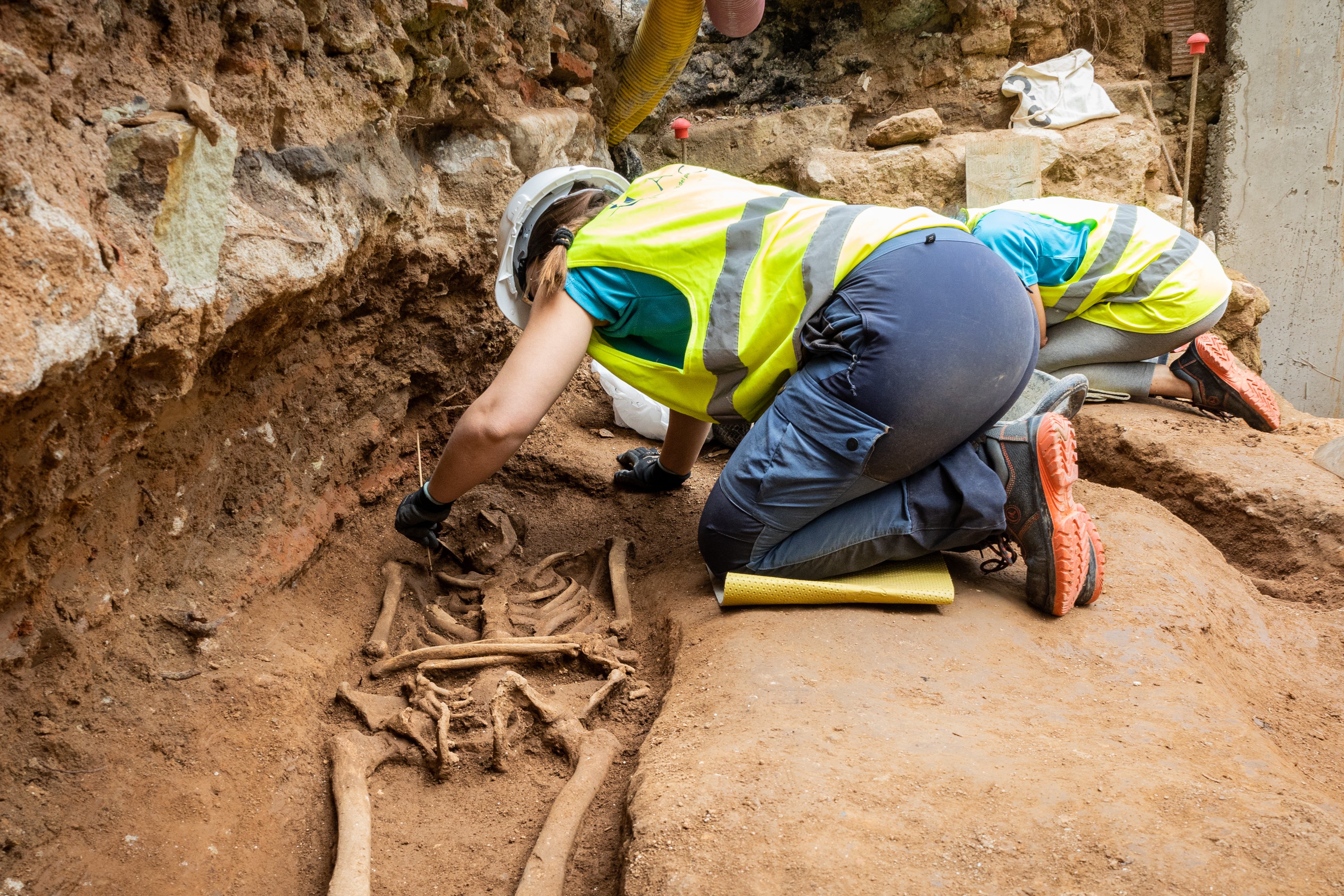The ongoing reconstruction of the major Barcelona thoroughfare Via Laietana has brought to light new archaeological remains. If in February a skeleton from the 5th century of the common era (CE) appeared in one corner of Plaça Antoni Maura - on the Santa Caterina neighbourhood side of the street - where there were two graves found, important new remains have now appeared on the other side of the square, closer to the city's cathedral. Specifically, two skeletons from the Late Antiquity period - the 6th and 7th centuries CE - have been found next to a complex of seven Roman graves dated from between the 4th and 5th centuries CE. In total, the resting places of eleven people who probably lived in, and certainly died in, the city called Barcino by the Romans have been unearthed due to the redevelopment works of Via Laietana.
On this occasion, the archaeological work was being carried out because of the need to excavate this particular area as a prelude to installing flowerbeds and trees there. Although from a historical point of view the existence of graves in this area, located just metres beyond the line of the old Roman wall, is not surprising, it is noteworthy that remains of this type can still be found in Via Laietana, in an area which has had more holes put through it than a Swiss cheese over the last hundred years with underground car parks - on Avinguda de la Catedral and opposite, on Francesc Cambó - and a Metro line, as Laia Macià, responsible for works at the Barcelona Archeology Service, explained on Tuesday.
Graves are not the only thing that has been found in this part of the Maura square, as remains of walls and food preservation silos have also appeared in different strata - at heights matching the modern, medieval and Roman eras. According to the archaeologist Joan Garriga, director of the dig, it was "excavated in layers", so that in the upper stratum "19th century floors" were found and in lower layers, "the remains from Late Antiquity (3rd-7th century) and Roman periods", and they do not rule out the possibility of going even deeper. In addition, Garriga pointed out the good state of preservation of the Late Antiquity skeletons, while the area of the Roman graves, where it is not ruled out that there may be more human remains, are more altered by the construction of more recent walls.



One key aspect to take into account is that, despite the nearby tunneling in the last hundred years, the excavated area had, until then, been occupied by older buildings of Barcelona's Ciutat Vella. It was opened up by the creation of the broad traffic street of Via Laietana at the beginning of the 20th century, followed by the opening of the now-pedestrianized Avinguda Catedral, in the decades after the Civil War, when the area was badly bombed. Indeed, a further point of interest revealed by the dig is that the finds are located right next to the remains of a Roman domus or home which preserves original mosaics and which, pending work to reinforce its structure, could be reopened to the public in the near future. In any case, the multiple findings at the different strata reveal "how the city has evolved from the oldest times to the most modern". In addition, Garriga highlights as a special find "two marble fragments", found at two different layers but which fit perfectly and where the letters 'I' and 'N' can be read, although it is not known if it was part of a tombstone.
Hundreds of graves that are no longer
What is clear is that the area now occupied by Via Laietana and formerly located just outside the walls of the Roman city was a common burial area, and in fact, when the tunnels were put through last century, in all probability “hundreds of graves would have been found”, which, unfortunately, were not documented to the same archaeological standards as today.



As for the future of the remains, it will probably follow the same pattern as for the finds made in February - that is to say, some elements, such as skeletons, will be removed, to be documented, studied and stored in the Barcelona Cultural Institute (ICUB) facilities in the Zona Franca, while the rest will be documented and buried again - a common archaeological practice when there is no museumization project, as happened recently with the remains of a 16th century farmhouse found in Carrer Girona in the Eixample district's "Green Axes" redevelopment.
Finally, the more prosaic question which is also inevitably on the mind of residents: when will the construction work finish? It is standard procedure to carry out archaeological surveys on any work that affects the historical heritage of the city, and it can take its time. Although this excavation isn't necessarily the reason for delaying the redevelopment of Via Laietana, the forecast was to complete the top half of the street, between Places Urquinaona and Antoni Maura, by April, and with June around the corner, the work goes on. As for the second phase of the works, the downtown end of the street between Antoni Maura and Correus, it was already clear that this was a pending matter for the next council, and now, after last Sunday's elections, it is a question of waiting to know whether the future municipal government will be inclined to complete the job or find a compromise solution combining one half of Via Laietana converted to the superblock model, and the other half of it as the same old Via Laietana that we all know and (cough, cough) love.


